+ Open data
Open data
- Basic information
Basic information
| Entry | Database: PDB / ID: 1bfe | ||||||
|---|---|---|---|---|---|---|---|
| Title | THE THIRD PDZ DOMAIN FROM THE SYNAPTIC PROTEIN PSD-95 | ||||||
 Components Components | PSD-95 DLG4 DLG4 | ||||||
 Keywords Keywords | PEPTIDE RECOGNITION /  PROTEIN LOCALIZATION PROTEIN LOCALIZATION | ||||||
| Function / homology |  Function and homology information Function and homology informationRHO GTPases activate CIT / positive regulation of AMPA glutamate receptor clustering / neuronal ion channel clustering / P2Y1 nucleotide receptor binding /  beta-1 adrenergic receptor binding / Neurexins and neuroligins / neuroligin family protein binding / receptor localization to synapse / positive regulation of neuron projection arborization / regulation of grooming behavior ...RHO GTPases activate CIT / positive regulation of AMPA glutamate receptor clustering / neuronal ion channel clustering / P2Y1 nucleotide receptor binding / beta-1 adrenergic receptor binding / Neurexins and neuroligins / neuroligin family protein binding / receptor localization to synapse / positive regulation of neuron projection arborization / regulation of grooming behavior ...RHO GTPases activate CIT / positive regulation of AMPA glutamate receptor clustering / neuronal ion channel clustering / P2Y1 nucleotide receptor binding /  beta-1 adrenergic receptor binding / Neurexins and neuroligins / neuroligin family protein binding / receptor localization to synapse / positive regulation of neuron projection arborization / regulation of grooming behavior / structural constituent of postsynaptic density / synaptic vesicle maturation / proximal dendrite / AMPA glutamate receptor clustering / cerebellar mossy fiber / protein localization to synapse / cellular response to potassium ion / vocalization behavior / LGI-ADAM interactions / neuron spine / Trafficking of AMPA receptors / beta-1 adrenergic receptor binding / Neurexins and neuroligins / neuroligin family protein binding / receptor localization to synapse / positive regulation of neuron projection arborization / regulation of grooming behavior / structural constituent of postsynaptic density / synaptic vesicle maturation / proximal dendrite / AMPA glutamate receptor clustering / cerebellar mossy fiber / protein localization to synapse / cellular response to potassium ion / vocalization behavior / LGI-ADAM interactions / neuron spine / Trafficking of AMPA receptors /  dendritic branch / Activation of Ca-permeable Kainate Receptor / juxtaparanode region of axon / neuron projection terminus / establishment or maintenance of epithelial cell apical/basal polarity / dendritic spine morphogenesis / negative regulation of receptor internalization / postsynaptic neurotransmitter receptor diffusion trapping / dendritic branch / Activation of Ca-permeable Kainate Receptor / juxtaparanode region of axon / neuron projection terminus / establishment or maintenance of epithelial cell apical/basal polarity / dendritic spine morphogenesis / negative regulation of receptor internalization / postsynaptic neurotransmitter receptor diffusion trapping /  frizzled binding / dendritic spine organization / frizzled binding / dendritic spine organization /  acetylcholine receptor binding / positive regulation of synapse assembly / RAF/MAP kinase cascade / Synaptic adhesion-like molecules / neurotransmitter receptor localization to postsynaptic specialization membrane / positive regulation of dendrite morphogenesis / acetylcholine receptor binding / positive regulation of synapse assembly / RAF/MAP kinase cascade / Synaptic adhesion-like molecules / neurotransmitter receptor localization to postsynaptic specialization membrane / positive regulation of dendrite morphogenesis /  beta-2 adrenergic receptor binding / regulation of neuronal synaptic plasticity / locomotory exploration behavior / cortical cytoskeleton / beta-2 adrenergic receptor binding / regulation of neuronal synaptic plasticity / locomotory exploration behavior / cortical cytoskeleton /  regulation of NMDA receptor activity / regulation of NMDA receptor activity /  social behavior / positive regulation of excitatory postsynaptic potential / AMPA glutamate receptor complex / social behavior / positive regulation of excitatory postsynaptic potential / AMPA glutamate receptor complex /  kinesin binding / neuromuscular process controlling balance / kinesin binding / neuromuscular process controlling balance /  excitatory synapse / excitatory synapse /  D1 dopamine receptor binding / Unblocking of NMDA receptors, glutamate binding and activation / D1 dopamine receptor binding / Unblocking of NMDA receptors, glutamate binding and activation /  glutamate receptor binding / positive regulation of protein tyrosine kinase activity / positive regulation of synaptic transmission / glutamate receptor binding / positive regulation of protein tyrosine kinase activity / positive regulation of synaptic transmission /  ionotropic glutamate receptor binding / ionotropic glutamate receptor binding /  extrinsic component of cytoplasmic side of plasma membrane / dendrite cytoplasm / extrinsic component of cytoplasmic side of plasma membrane / dendrite cytoplasm /  synaptic membrane / synaptic membrane /  PDZ domain binding / cell periphery / postsynaptic density membrane / regulation of long-term neuronal synaptic plasticity / PDZ domain binding / cell periphery / postsynaptic density membrane / regulation of long-term neuronal synaptic plasticity /  neuromuscular junction / establishment of protein localization / neuromuscular junction / establishment of protein localization /  cell-cell adhesion / cerebral cortex development / cell-cell adhesion / cerebral cortex development /  kinase binding / cell-cell junction / kinase binding / cell-cell junction /  synaptic vesicle / synaptic vesicle /  cell junction / positive regulation of cytosolic calcium ion concentration / chemical synaptic transmission / cell junction / positive regulation of cytosolic calcium ion concentration / chemical synaptic transmission /  postsynaptic membrane / postsynapse / postsynaptic membrane / postsynapse /  scaffold protein binding / basolateral plasma membrane / protein-containing complex assembly / scaffold protein binding / basolateral plasma membrane / protein-containing complex assembly /  protein phosphatase binding / protein phosphatase binding /  dendritic spine / dendritic spine /  postsynaptic density / neuron projection / postsynaptic density / neuron projection /  signaling receptor binding / signaling receptor binding /  dendrite / glutamatergic synapse / dendrite / glutamatergic synapse /  synapse / protein-containing complex binding / synapse / protein-containing complex binding /  protein kinase binding / protein kinase binding /  endoplasmic reticulum / endoplasmic reticulum /  membrane / membrane /  plasma membrane / plasma membrane /  cytosol / cytosol /  cytoplasm cytoplasmSimilarity search - Function | ||||||
| Biological species |   Rattus norvegicus (Norway rat) Rattus norvegicus (Norway rat) | ||||||
| Method |  X-RAY DIFFRACTION / X-RAY DIFFRACTION /  MIR / Resolution: 2.3 Å MIR / Resolution: 2.3 Å | ||||||
 Authors Authors | Doyle, D.A. / Lee, A. / Lewis, J. / Kim, E. / Sheng, M. / Mackinnon, R. | ||||||
 Citation Citation |  Journal: Cell(Cambridge,Mass.) / Year: 1996 Journal: Cell(Cambridge,Mass.) / Year: 1996Title: Crystal structures of a complexed and peptide-free membrane protein-binding domain: molecular basis of peptide recognition by PDZ. Authors: Doyle, D.A. / Lee, A. / Lewis, J. / Kim, E. / Sheng, M. / MacKinnon, R. #1:  Journal: Nat.Struct.Biol. / Year: 1998 Journal: Nat.Struct.Biol. / Year: 1998Title: Crystal Structure of the Hcask Pdz Domain Reveals Structural Basis of Class II Pdz Domain Target Recognition Authors: Daniels, D.L. / Cohen, A.R. / Anderson, J.M. / Brunger, A.T. #2:  Journal: Nature / Year: 1996 Journal: Nature / Year: 1996Title: Crystal Structure of a Pdz Domain Authors: Cabral, M. / Petosa, C. / Sutcliffe, M.J. / Raza, S. / Byron, O. / Poy, F. / Marfatia, S.M. / Chishti, A.H. / Liddington, R.C. | ||||||
| History |
|
- Structure visualization
Structure visualization
| Structure viewer | Molecule:  Molmil Molmil Jmol/JSmol Jmol/JSmol |
|---|
- Downloads & links
Downloads & links
- Download
Download
| PDBx/mmCIF format |  1bfe.cif.gz 1bfe.cif.gz | 34.2 KB | Display |  PDBx/mmCIF format PDBx/mmCIF format |
|---|---|---|---|---|
| PDB format |  pdb1bfe.ent.gz pdb1bfe.ent.gz | 24.2 KB | Display |  PDB format PDB format |
| PDBx/mmJSON format |  1bfe.json.gz 1bfe.json.gz | Tree view |  PDBx/mmJSON format PDBx/mmJSON format | |
| Others |  Other downloads Other downloads |
-Validation report
| Arichive directory |  https://data.pdbj.org/pub/pdb/validation_reports/bf/1bfe https://data.pdbj.org/pub/pdb/validation_reports/bf/1bfe ftp://data.pdbj.org/pub/pdb/validation_reports/bf/1bfe ftp://data.pdbj.org/pub/pdb/validation_reports/bf/1bfe | HTTPS FTP |
|---|
-Related structure data
- Links
Links
- Assembly
Assembly
| Deposited unit | 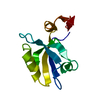
| ||||||||||||
|---|---|---|---|---|---|---|---|---|---|---|---|---|---|
| 1 |
| ||||||||||||
| Unit cell |
| ||||||||||||
| Components on special symmetry positions |
|
- Components
Components
| #1: Protein |  DLG4 DLG4Mass: 12750.126 Da / Num. of mol.: 1 / Fragment: THE THIRD PDZ DOMAIN OF PSD-95 Source method: isolated from a genetically manipulated source Source: (gene. exp.)   Rattus norvegicus (Norway rat) / Plasmid: PGEX-4T-1 / Species (production host): Escherichia coli / Production host: Rattus norvegicus (Norway rat) / Plasmid: PGEX-4T-1 / Species (production host): Escherichia coli / Production host:   Escherichia coli BL21 (bacteria) / Strain (production host): BL21 / References: UniProt: P31016 Escherichia coli BL21 (bacteria) / Strain (production host): BL21 / References: UniProt: P31016 |
|---|---|
| #2: Water | ChemComp-HOH /  Water Water |
-Experimental details
-Experiment
| Experiment | Method:  X-RAY DIFFRACTION / Number of used crystals: 1 X-RAY DIFFRACTION / Number of used crystals: 1 |
|---|
- Sample preparation
Sample preparation
| Crystal | Density Matthews: 2.32 Å3/Da / Density % sol: 46.95 % | ||||||||||||||||||||||||
|---|---|---|---|---|---|---|---|---|---|---|---|---|---|---|---|---|---|---|---|---|---|---|---|---|---|
Crystal grow | pH: 7.5 / Details: 0.8 M SODIUM CITRATE, 0.1 M HEPES, PH 7.5 | ||||||||||||||||||||||||
| Crystal | *PLUS | ||||||||||||||||||||||||
| Crystal grow | *PLUS Method: vapor diffusion, sitting drop | ||||||||||||||||||||||||
| Components of the solutions | *PLUS
|
-Data collection
| Diffraction | Mean temperature: 100 K |
|---|---|
| Diffraction source | Source:  ROTATING ANODE / Type: SIEMENS / Wavelength: 1.5418 ROTATING ANODE / Type: SIEMENS / Wavelength: 1.5418 |
| Detector | Type: MARRESEARCH / Detector: IMAGE PLATE / Date: Jan 1, 1996 / Details: COLLIMATOR |
| Radiation | Monochromator: NI FILTER / Monochromatic (M) / Laue (L): M / Scattering type: x-ray |
| Radiation wavelength | Wavelength : 1.5418 Å / Relative weight: 1 : 1.5418 Å / Relative weight: 1 |
| Reflection | Resolution: 2.2→20 Å / Num. obs: 6421 / % possible obs: 96.6 % / Observed criterion σ(I): 2 / Rmerge(I) obs: 0.036 |
| Reflection shell | Resolution: 2.3→2.38 Å / Rmerge(I) obs: 0.166 / % possible all: 86.7 |
| Reflection | *PLUS Num. measured all: 38267 |
| Reflection shell | *PLUS % possible obs: 90.2 % |
- Processing
Processing
| Software |
| ||||||||||||
|---|---|---|---|---|---|---|---|---|---|---|---|---|---|
| Refinement | Method to determine structure : :  MIR / Resolution: 2.3→20 Å / Rfactor Rfree MIR / Resolution: 2.3→20 Å / Rfactor Rfree : 0.315 / Rfactor Rwork : 0.315 / Rfactor Rwork : 0.214 : 0.214 | ||||||||||||
| Refinement step | Cycle: LAST / Resolution: 2.3→20 Å
| ||||||||||||
| Software | *PLUS Name:  X-PLOR / Classification: refinement X-PLOR / Classification: refinement | ||||||||||||
| Refinement | *PLUS Highest resolution: 2.3 Å / Rfactor obs: 0.214 / Rfactor Rfree : 0.315 / Lowest resolution: 6 Å / σ(F): 2 / % reflection Rfree: 10 % / Num. reflection obs: 5322 : 0.315 / Lowest resolution: 6 Å / σ(F): 2 / % reflection Rfree: 10 % / Num. reflection obs: 5322 | ||||||||||||
| Solvent computation | *PLUS | ||||||||||||
| Displacement parameters | *PLUS | ||||||||||||
| Refine LS restraints | *PLUS
|
 Movie
Movie Controller
Controller



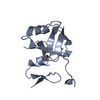

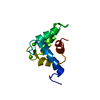
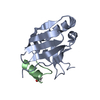
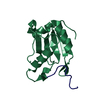

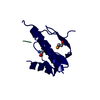
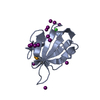



 PDBj
PDBj




